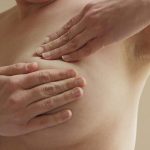 One of two glands in a woman which secrete milk.
One of two glands in a woman which secrete milk.
A pair of hemispheric structures on the chest of mature females, composed largely of fatty tissue, surrounding 15 to 20 milk-secreting glands (physiologically modified sweat glands), with milk funneled into the nipple in the middle. Children and men have undeveloped breasts. Under some conditions, as when taking female hormones, a child’s or male’s breasts can develop a condition called gynecomastia; newborns may also sometimes have enlarged breasts, in response to the mother’s hormones, and may even produce breastmilk, popularly called witch’s milk.
Front of the chest, esp. either of the two masses of tissue mammary glands that include and surround the nipples. In females the mammary glands produce milk after the birth or a baby. Each breast is made up of glandular lobules that secrete milk. The milk passes into ducts (lactiferous ducts), is stored in dilations of the ducts (ampullae), and is discharged through tiny openings in the nipple area.
One of the pair of organs attached to the chest consisting of milk- producing glands, blood vessels, fat, and connective tissue. In women, the foremost function of the breasts is to secrete milk to feed an infant. The breast is also sensitive to sexual stimulation.
The mammary gland of a woman: one of two compound glands that produce milk. Each breast consists of glandular lobules (the milk-secreting areas) embedded in fatty tissue. The milk passes from the lobules into ducts, which join up to form 15-20 lactiferous ducts. Near the front of the breast the lactiferous ducts are dilated into ampullae, which act as reservoirs for the milk. Each lactiferous duct discharges through a separate orifice in the nipple. The dark area around the nipple is called the areola.
Breasts, or mammary glands, occur only in mammals and provide milk for feeding the young. These paired organs are usually fully developed only in adult females, but are present in rudimentary form in juveniles and males. In women, the two breasts over-lie the second to sixth ribs on the front of the chest. On the surface of each breast is a central pink disc called the areola, which surrounds the nipple. Inside, the breast consists of fat, supporting tissue and glandular tissue, which is the part that produces milk following childbirth. Each breast consists of 12—20 compartments arranged radially around the nipple: each compartment opens on to the tip of the nipple via its own duct through which the milk flows. The breast enlargement that occurs in pregnancy is due to development of the glandular part in preparation for lactation. In women beyond childbearing age, the glandular part of the breasts reduces (called involution) and the breasts become less firm and contain relatively more fat.
Each of the two mammary glands, known as breasts, serves as a source of nourishment for infants in women. They function by producing milk and are considered secondary sexual characteristics. In males, the breast is an underdeveloped form compared to its mature counterpart found in females.
During puberty, the breast development process initiates in girls. It involves various changes, such as the swelling of the areola (the pigmented skin area encircling the nipple) and the enlargement of the nipple itself. Subsequently, there is a growth in both glandular tissue and fatty deposits within the breasts, contributing to their development and maturation.
In the fully developed adult female breast, there are approximately 15 to 20 lobes comprising milk-secreting glands, which are embedded within adipose (fatty) tissue. The ducts of these glands connect to the nipple, serving as the outlet for milk secretion. The areolar skin surrounding the nipple contains sweat glands, sebaceous glands, and hair follicles. The breast’s height and shape are determined by delicate ligamentous bands that provide structural support. Collectively, these anatomical components contribute to the functional and aesthetic characteristics of the adult female breast.
The size, shape, and overall appearance of a woman’s breasts can undergo fluctuations throughout different stages of her reproductive life. These variations occur during the menstrual cycle, pregnancy, and lactation, as well as after the onset of menopause. Hormonal changes and physiological processes influence these changes, resulting in differences in breast size, shape, and aesthetic characteristics during these distinct periods in a woman’s life.
During pregnancy, the hormones estrogen and progesterone, produced by the ovaries and placenta, play a vital role. They stimulate the development and activation of the milk-producing glands within the breast. Additionally, these hormones contribute to the enlargement of the nipples, preparing them for the breastfeeding phase. The combined effects of estrogen and progesterone create the necessary physiological changes to support lactation and the nurturing of the newborn.
In the period leading up to childbirth and immediately following it, the glands within the breast generate a thin and watery fluid known as colostrum. This initial production is eventually replaced by the production of milk a few days later. The hormone prolactin plays a crucial role in stimulating the production and release of milk. Through the action of prolactin, the mammary glands are prompted to produce an adequate supply of nourishing milk, facilitating the breastfeeding process and providing essential nutrients for the newborn.
The female milk-producing organ, known as the mammary gland, consists of 15 to 20 individual lobes. Each of these lobes has a tiny milk duct that leads toward the nipple. In some newborns, the nipple may appear enlarged and may even excrete a milky substance referred to as “witch’s milk.” This early development is due to the influence of female sex hormones passed from the mother to the baby. The condition usually resolves on its own without any medical intervention.
